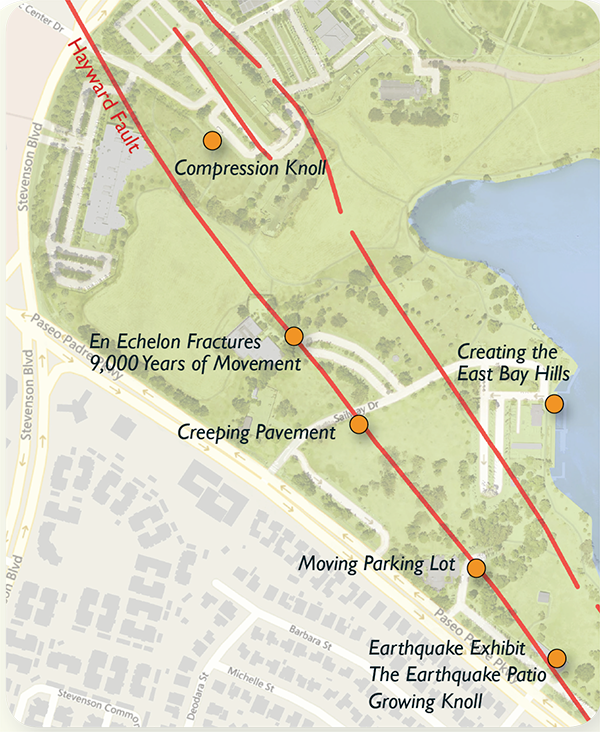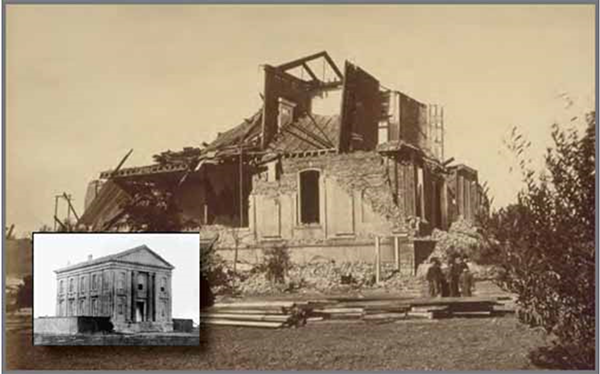|

This tour is great for
older elementary age children and adults. It shows the
power of an earthquake without fear. In Earthquake Country
knowledge of earthquakes is important. Class include a
tour of the features in Central Park. Learn how Stivers
Lagoon and Lake Elizabeth were created. Other faults
in the bay area will be discussed and important clues on how to
think when an earthquake occurs. 1.5 hour long, tour 1 mile
Cost: $15 per person (not recommended for under 5)
includes Faults of the Bay Area T Shirt (large, medium,
small) while supply lasts
The Hayward Fault has shaped the landscape
of the East Bay for the last million years.
The last large earthquake was on October 21, 1968, when a 6
foot offset was ripped from Milpitas to San Leandro.
In certain places there was an uplift of 4-6 feet.
Hayward, San Leandro, Oakland and San Francisco had major
damage. Fremont’s
Mission San Jose crumpled. The
Hayward Fault has created the scenic hills and valleys in the East
Bay. Much of the length of the Hayward Fault outlines the
hills of the Diablo Range. However in Fremont, the Hayward
Fault's trace is through the flatland.
The Hayward fault, running through the East Bay from the North Bay to Santa Clara County, is one of a handful of faults in the world that ‘creeps’ at the surface. Fault creep, where a fault moves steadily at the surface (instead of staying locked by friction, like most faults), has many observable effects in the East Bay – it separates curbs and paving slabs, cracks asphalt and walls, and damages buildings, most notably the Berkeley football stadium. The rate of movement, around 5 mm per year in Fremont, is enough to visibly move objects within a year or two.
Geophysicists are interested in this unusual behavior for a couple of reasons. First, we want to explain why some faults creep and others do not – why it happens on the Hayward fault in Fremont, and not (for example) on the San Andreas fault in Palo Alto. Second, and more importantly, knowing where and how fast the Hayward fault creeps allows us to make estimates of where it is not creeping. These ‘locked’ areas are accumulating strain for a future earthquake. We know that there was a large earthquake on the Hayward fault in 1868, and our best estimates suggest that there is a high probability of a repeat earthquake in the next few decades. Understanding in advance where this earthquake will happen will allow citizens, the public utilities and city governments to prepare for the worst.

Come see the "Faulted Floor" Exhibit. See a map of
the East Bay and where the Hayward Fault is ripping it apart.
For more information on the Faulted Floor Exhibit which is a
permanent exhibit
click here.
(left - San Leandro City Hall devastated in 1868)
 |
MATH SCIENCE NUCLEUS
since 1982 has served the education and public by
offering quality science and math lessons that take our
children learn critical thinking skills. We manage the
Children's Natural History Museum and Tule Ponds at
Tyson Lagoon Wetland Center.
http://msnucleus.org.
|
Math/Science Nucleus
4074 Eggers Drive, Fremont, California, U.S.A., 94536
(510) 790-6284
msn@msnucleus.org
|